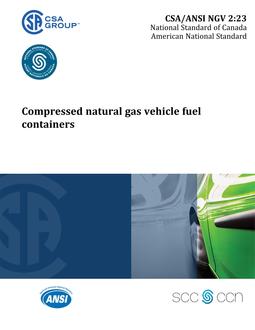Preface
This is the seventh edition of CSA/ANSI NGV 2, Compressed natural gas vehicle fuel containers. It supersedes the previous editions published in 2019, 2016, 2007, 2000, 1998, and 1992. Significant changes in this edition include the following: a) incorporated Canadian specific requirements that harmonize coverage with CSA B51, Part 2; b) streamlined the bonfire test to make it more representative of a component level test allowing localized fire test to be performed at system level standards; and c) adjusted the permeation test. This Standard is considered suitable for use for conformity assessment within the stated scope of the Standard. CSA Group acknowledges that the development of this Standard was made possible, in part, by the financial support of Natural Resources Canada. This Standard was prepared by the Subcommittee on Fuel Containers for Compressed Natural Gas Vehicles, under the jurisdiction of the Technical Committee on Natural Gas Transportation and the Strategic Steering Committee on Transportation, and has been formally approved by the Technical Committee and IGAC. This Standard has been developed in compliance with Standards Council of Canada requirements for National Standards of Canada. It has been published as a National Standard of Canada by CSA Group. This Standard has been approved by the American National Standards Institute (ANSI) as an American National Standard.
Scope
1.1 General
This Standard concerns high-pressure containers for the on-board storage of natural gas as a fuel for automotive vehicles. This Standard contains requirements for the material, design, manufacture, and testing of serially produced, refillable Type NGV 2 containers intended for the storage of compressed natural gas (CNG) for vehicle operation. These containers are to be permanently attached to the vehicle. This Standard applies to containers up to and including 1000 L (35.4 ft3) water capacity. Note: In Canada, the use of gas containers is governed by the Act. In the United States, the use of gas containers is governed by the U.S. Department of Transportation
1.2 Container types
1.2.1 Cylindrical containers Type NGV 2 containers are designated as follows: a) Type 1: metal; b) Type 2: hoop-wrapped container with resin-impregnated continuous filaments and a metal liner with a minimum burst pressure of 125% of service pressure; c) Type 3: fully wrapped container with resin-impregnated continuous filaments and with a metal liner; and d) Type 4: fully wrapped container with resin-impregnated continuous filaments and with a nonmetallic liner.
1.2.2 Conformable containers Conformable container types are designated as follows: a) CT1: container or assembly of a non-cylindrical or non-spherical (i.e., irregular) shape without a protective shell (i.e., outside wall containing gas pressure); b) CT2: container or assembly of possibly irregular shape within a conformable protective shell that is acting as a shield and not directly assisting the inner container with containing gas pressure; and c) CT3: container or assembly of possibly irregular shape within a conformable protective shell that is acting as a shield and directly assisting the inner container with containing gas pressure. The conformable container types are an additional identifier that is used in combination with the container type. A conformable container is designated based on the design as a Type 1 (metal) to Type 4 (resin-impregnated continuous filament with a nonmetallic liner) with the additional conformable type identifier. For example, a Type 4 CT2 container would be required to meet the criteria for a Type 4 container as well as the criteria specified for a CT2 container.
1.3 Welded containers
This Standard does not cover welded metal containers or liners.
1.4 Precedence of requirements
Where a clause in this Standard conflicts with codes or standards referenced in this Standard, the requirements of this Standard take precedence.
1.5 Requalification of containers
Type 1 steel containers may be requalified for further service in accordance with the procedure described in Annex E.
1.6 Canadian specific requirements
Annex A contains requirements that are applicable only to Canada.
1.7 Terminology
In this Standard, “shall” is used to express a requirement, i.e., a provision that the user is obliged to satisfy in order to comply with the Standard; “should” is used to express a recommendation or that which is advised but not required; and “may” is used to express an option or that which is permissible within the limits of the Standard. Notes accompanying clauses do not include requirements or alternative requirements; the purpose of a note accompanying a clause is to separate from the text explanatory or informative material. Notes to tables and figures are considered part of the table or figure and may be written as requirements. Annexes are designated normative (mandatory) or informative (non-mandatory) to define their application.
1.8 Units of measure
The values given in SI units are the units of record for the purposes of this Standard. The values given in parentheses are for information and comparison only. See also Annex D.
Product Details
- Edition:
- 7th
- Published:
- 06/20/2023
- ISBN(s):
- 9781488345005
- ANSI:
- ANSI Approved
- Number of Pages:
- 97
- File Size:
- 1 file , 1.2 MB
- Product Code(s):
- 2430289, 2430289
- Note:
- This product is unavailable in Russia, Ukraine, Belarus
